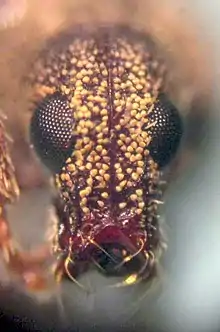| Polydacrys | |
|---|---|
 | |
| Head of Polydacrys sp. | |
| Scientific classification | |
| Kingdom: | |
| Phylum: | |
| Class: | |
| Order: | |
| Family: | |
| Subfamily: | |
| Tribe: | |
| Genus: | Polydacrys Schönherr, 1834 |
Polydacrys is a genus of broad-nosed weevils in the beetle family Curculionidae, subfamily Entiminae,[1] tribe Anypotactini, present across the Americas and the Caribbean. There are eight described species in Polydacrys.[2][3]
Taxonomy
Polydacrys was described for the first time by Carl Johan Schönherr in 1834 (p. 130).[4] It was previously considered a member of the Tanymecini.[5]
There is a key to the Central American species of Polydacrys in Champion (1911: 217).[6]
Description
Members of Polydacrys are small (~6 to 12 mm) and can be recognized by their nasal plate, which is triangular, large, glabrous, shiny, and elevated from the surface of the rostrum.[5] In addition, their mandibular scars are projected from the surface of the mandible.
Distribution
Members of Polydacrys range from Texas through Bolivia and are particularly well-represented across the Caribbean.[1]
Species
These eight species belong to the genus Polydacrys [2][3]:
- Polydacrys bolivianus Voss, 1932: 36:[7] Bolivia.
- Polydacrys brevicollis Champion, 1911: 215:[6] Guatemala.
- Polydacrys depressifrons Boheman, 1840: 298 [8]= Pandeletejus cavirostris Schaeffer, 1908: 214; = Pandeleteius nubilosus Boheman, 1840: 296:[8] Texas, Belize, Costa Rica, El Salvador, Guatemala, Honduras, Mexico, Nicaragua, Panama, Grenada, Puerto Rico, Saint Vincent.
- Polydacrys moestus Chevrolat, 1880: 190 [9]= Polydacrys nigrosparsus Chevrolat, 1880: 190:[9] Guadeloupe.
- Polydacrys mucronatus Champion, 1911: 219:[6] Costa Rica, Panama.
- Polydacrys nigrofasciatus Champion, 1911: 219:[6] El Salvador, Mexico
- Polydacrys scansorius (Klug, 1829): 13 [10] = Polydacrys modestus Gyllenhal, 1834: 131:[4] Cuba, Dominica, Guadeloupe.
- Polydacrys seriegranosus Champion, 1911: 218:[6] Panama, Bolivia, Colombia.
References
- 1 2 Alonso-Zarazaga, M. A.; Lyal, C. H. C. (1999). A world catalogue of families and genera of Curculionoidea (Insecta: Coleoptera) excluding Scolytidae and Platypodidae (PDF). Barcelona, Spain: Entomopraxis. pp. 315 pp.
- 1 2 O’Brien, C. W.; Wibmer, G. J. (1982). "Annotated checklist of the weevils (Curculionidae sensu lato) of North America, Central America, and the West Indies (Coleoptera: Curculionoidea)" (PDF). Memoirs of the American Entomological Institute. 34: 1–382.
- 1 2 Wibmer, G. J.; O’Brien, C. W. (1986). "Annotated checklist of the weevils (Curculionidae sensu lato) of South America (Coleoptera: Curculionoidea)". Memoirs of the American Entomological Institute. 39: 1–563.
- 1 2 Schönherr, C. J. (1834). Genera et species Curculionidum, cum synonymia hujus familiae. Species novae aut hactenus minus cognitae, descriptionibus a Dom. Leonardo Gyllenhal, C. H. Boheman, et entomologis aliis illustratae, tomus secundus, pars prima. Paris: Roret. pp. 673 pp.
- 1 2 van Emden, F.I. (1944). "L.— A key to the genera of Brachyderinæ of the World". Annals and Magazine of Natural History. 11 (81): 559–586. doi:10.1080/00222934408527456. ISSN 0374-5481.
- 1 2 3 4 5 Sharp, D.; Champion, G.C. (1911). Biologia Centrali-Americana. Insecta. Coleoptera. Volume 4. part 3. Rhynchophora. Curculionidae. London: R. H. Porter. pp. 354 + pl. 15 pp.
- ↑ Voss, E. (1932). "Unbeschriebene neotropische Curculioniden. I. (35. Beitrag zur Kenntnis der Curculioniden)". Revista de entomologia. Rio de Janeiro. 2: 33–43.
- 1 2 Schönherr, C.J. (1840). Genera et species Curculionidum, cum synonymia hujus familiae. Species novae aut hactenus minus cognitae, descriptionibus a Dom. Leonardo Gyllenhal, C. H. Boheman, et entomologis aliis illustratae, tomus sextus, pars prima. Paris: Roret. pp. 474 pp.
- 1 2 Chevrolat, L.A.A. (1880). "Diagnoses de Curculionides des Antilles". Le Naturaliste. 2: 190–191.
- ↑ Klug, Fr (1829). Preis-verzeichniss vorräthiger insectendoubletten des Königl: zoologischen museums der Universität. Berlin: s.n.